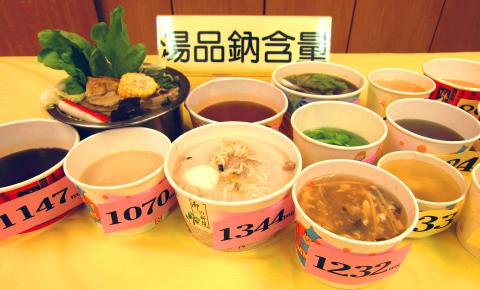For the sheer sake of convenience, many people go down to their nearest convenience store for some Japanese oden or instant noodles as a quick and easy meal. The John Tung Foundation, however, has found that the average bowl of oden soup — 80 percent full — can contain between 600mg and 1,400mg of salt — a significant amount of variance.
Although convenience stores have specific standards and processes for diluting soups, many convenience store clerks adjust flavor according to their own individual palette, and by continuously heating soups and not adding water periodically, sodium levels rise as it continues to cook. The amount of sodium in spicy oden soup is much higher than that of clear-broth oden, so eating less of the food to avoid consuming too much sodium and subsequently harming your health is recommended.
According to the most recent national report on nutrition conducted by the Bureau of Health Promotion under the Department of Health (DOH), the average adult female consumes 3,567mg of sodium every day while the average male takes in 4,579mg, both significantly higher than the DOH’s recommended daily salt intake of 2,400mg.

Photo: Fang Pin-chao, Liberty Times
照片:自由時報記者方賓照
Lu Hui-ju, one of the foundation’s nutritionists, says that Chinese people love eating soup, and according to the foundation’s recent survey, more than 80 percent of people are aware that salt, sauces and processed foods are all common sources of sodium, but overlook the fact that soup is also a significant source of sodium.
The foundation recently conducted a survey of sodium levels in 95 bowls of soup from buffet restaurants, bento box eateries, snack shops, luwei (meats, vegetables or tofu braised in a soy sauce broth) stands, convenience stores and hotpot establishments. The results showed that, although some soups at hotpot shops might taste bland, they can contain as much as 2,600mg of sodium in a single serving, which exceeds the recommended total daily amount of sodium a person should consume.
Lu says that excessive sodium intake can cause edema, hypertension, kidney disease, arteriosclerosis and coronary heart disease. Many people mistakenly assume that if something does not taste salty that it must not contain much sodium, but sodium levels cannot actually be determined by looking at the color of a soup or at how thick it is. Lu suggests that people should reduce the amount of takeaway soups they eat, or at least check sodium levels prior to consumption, but says that the labels on soups at some convenience stores are too small, making them difficult to read and something that needs to be improved.

Photo: Wei Yi-chia, Liberty Times
照片:自由時報記者魏怡嘉
(Liberty Times, Translated by Kyle Jeffcoat)
為了方便,不少民眾會就近到超商吃「關東煮」或泡麵解決一餐,但董氏基金會調查發現,一碗八分滿的「關東煮」湯裡的鈉含量約從六百毫克到一千四百毫克,差距很大。
雖然超商稀釋濃高湯有一定的標準作業流程,但不少超商店員是依照自己的口味調味,再加上一直加熱,未定時加水,使得鈉含量愈煮愈高,其中麻辣湯的鈉含量又比原味湯高,建議民眾少喝,以免攝取過量,造成身體負擔。
根據衛生署國民健康局進行最新國民營養調查發現,我國成年女性每日平均攝取鈉三千五百六十七毫克、男性四千五百七十九毫克,都遠超過衛生署建議的二千四百毫克,顯示國人飲食過鹹。
董氏基金會營養師呂蕙如表示,華人飲食文化愛喝湯,八成以上的民眾知道鹽、沾醬及加工食品是鈉的來源,但卻忽略了湯品也是食物中鈉的主要來源之一。
董氏基金會近日檢測自助餐、便當店、小吃店、滷味、便利商店及火鍋店等供應的九十五碗湯含鈉量,結果發現,部分連鎖小火鍋的湯頭,喝起來雖然清淡,但一鍋湯的含鈉量竟高達二千六百毫克,已超過人每日建議攝取量的二千四百毫克。
呂蕙如指出,鈉攝取過多會造成水腫、高血壓、腎臟病、動脈硬化及冠狀動脈心臟病。很多民眾以為吃起來不鹹,含鈉量就一定低,其實是錯誤的觀念,湯的鈉含量是無法由湯的顏色及濃稠度去做判斷,建議民眾出門在外,少喝這些湯,或是飲用前先查看鈉含量的標示,但部分超商的鈉含量標示字體太小,民眾很難看得清楚,需要改進。
(自由時報記者魏怡嘉)

A: While Taylor Swift’s new album conquers the Billboard charts, Billboard Live Taipei is set to open next month. B: Isn’t that a Japanese “live house” of the same name with the magazine? A: Yup, and the live music club’s first Taiwanese branch can accommodate 300 guests. B: Who will be performing at the club’s opening show? A: Japanese singer Mika Nakashima will play four gigs over two nights. Wanna go to the club and watch her perform up-close? A: 天后泰勒絲的新專輯再度征服《告示牌》排行榜,告示牌音樂台北則預計將在下月開幕。 B: 那不是跟《告示牌》同名的日本現場音樂餐廳嗎? A: 對,這家連鎖餐廳的台灣首店約可容納300名觀眾! B: 開幕秀的表演者是誰? A: 是日本歌手中島美嘉,想近距離看她現場演出嗎? (By Eddy Chang,

In his famous tragic play Romeo and Juliet, the English playwright William Shakespeare wrote, “What’s in a name?” As it turns out, there is quite a lot in a name, particularly a surname, which is commonly known as a person’s last name in Western societies. A surname is written after the first name, which is also referred to as a given name or, traditionally, a Christian name. A closer look at the history of surnames reveals some fascinating insights into their origins. It may come as a surprise to some that up until about 1,000 years ago, surnames were

A: US singer Taylor Swift finally released her 12th album, titled “The Life of a Showgirl,” on Oct. 3. B: The pop diva’s dominating the Billboard charts once again. A: Earlier this year, she also successfully bought back the master recordings to her first six albums. B: And the good news keeps coming, as she and NFL superstar Travis Kelce announced their engagement not long ago. A: Wow! It must be her lucky year. A: 美國歌手泰勒絲10月3日終於推出第12張專輯︰《The Life of a Showgirl》。 B: 流行天后又再次稱霸《告示牌》排行榜。 A: 今年稍早時,她還成功買回了她自己前6張專輯的錄音母帶。 B: 而喜事連連,她和美式足球巨星凱爾西近日宣布他們訂婚了。 A: 哇今年真是她的幸運年! (By Eddy Chang, Taipei Times/台北時報張迪)

Continued from yesterday(延續自昨日) https://www.taipeitimes.com/News/lang While many early surnames in England were strongly influenced by the work people did, like Carpenter or Plumber, jobs were not the only factor. Physical characteristics, personal nicknames, geographical locations and even parents’ first names also played a role. It’s not hard to imagine how the color of a person’s hair could have led to a surname like “Redhead” or “White,” while a darker complexion might have resulted in the last name “Black.” Meanwhile, someone known as a quick runner might have earned the surname “Swift,” while a clever or cunning individual could have been called “Fox”